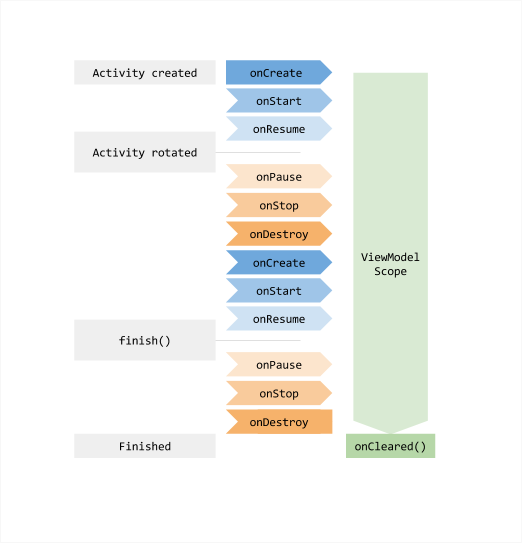ViewModel overview Part of Android Jetpack.
The ViewModel class is a business logic or screen level state
holder. It exposes state to the UI and encapsulates related business logic.
Its principal advantage is that it caches state and persists it through
configuration changes. This means that your UI doesn’t have to fetch data again
when navigating between activities, or following configuration changes, such as
when rotating the screen.
For more information on state holders, see the state holders guidance. Similarly, for more information on the UI layer generally, see the UI layer guidance.
ViewModel benefits
The alternative to a ViewModel is a plain class that holds the data you display in your UI. This can become a problem when navigating between activities or Navigation destinations. Doing so destroys that data if you don't store it using the saving instance state mechanism. ViewModel provides a convenient API for data persistence that resolves this issue.
The key benefits of the ViewModel class are essentially two:
- It allows you to persist UI state.
- It provides access to business logic.
Persistence
ViewModel allows persistence through both the state that a ViewModel holds, and the operations that a ViewModel triggers. This caching means that you don’t have to fetch data again through common configuration changes, such as a screen rotation.
Scope
When you instantiate a ViewModel, you pass it an object that implements the
ViewModelStoreOwner interface. This may be a Navigation destination,
Navigation graph, activity, fragment, or any other type that implements the
interface. Your ViewModel is then scoped to the Lifecycle of the
ViewModelStoreOwner. It remains in memory until its ViewModelStoreOwner
goes away permanently.
A range of classes are either direct or indirect subclasses of the
ViewModelStoreOwner interface. The direct subclasses are
ComponentActivity, Fragment, and NavBackStackEntry.
For a full list of indirect subclasses, see the
ViewModelStoreOwner reference.
When the fragment or activity to which the ViewModel is scoped is destroyed, asynchronous work continues in the ViewModel that is scoped to it. This is the key to persistence.
For more information, see the section below on ViewModel lifecycle.
SavedStateHandle
SavedStateHandle allows you to persist data not just through configuration changes, but across process recreation. That is, it enables you to keep the UI state intact even when the user closes the app and opens it at a later time.
Access to business logic
Even though the vast majority of business logic is present in the data layer, the UI layer can also contain business logic. This can be the case when combining data from multiple repositories to create the screen UI state, or when a particular type of data doesn't require a data layer.
ViewModel is the right place to handle business logic in the UI layer. The ViewModel is also in charge of handling events and delegating them to other layers of the hierarchy when business logic needs to be applied to modify application data.
Jetpack Compose
When using Jetpack Compose, ViewModel is the primary means of exposing screen UI state to your composables. In a hybrid app, activities and fragments simply host your composable functions. This is a shift from past approaches, where it wasn't that simple and intuitive to create reusable pieces of UI with activities and fragments, which caused them to be much more active as UI controllers.
The most important thing to keep in mind when using ViewModel with Compose is
that you cannot scope a ViewModel to a composable. This is because a composable
is not a ViewModelStoreOwner. Two instances of the same composable in the
Composition, or two different composables accessing the same ViewModel type
under the same ViewModelStoreOwner would receive the same instance of the
ViewModel, which often is not the expected behavior.
To get the benefits of ViewModel in Compose, host each screen in a Fragment or Activity, or use Compose Navigation and use ViewModels in composable functions as close as possible to the Navigation destination. That is because you can scope a ViewModel to Navigation destinations, Navigation graphs, Activities, and Fragments.
For more information, see the guide on state hoisting for Jetpack Compose.
Implement a ViewModel
The following is an example implementation of a ViewModel for a screen that allows the user to roll dice.
Kotlin
data class DiceUiState(
val firstDieValue: Int? = null,
val secondDieValue: Int? = null,
val numberOfRolls: Int = 0,
)
class DiceRollViewModel : ViewModel() {
// Expose screen UI state
private val _uiState = MutableStateFlow(DiceUiState())
val uiState: StateFlow<DiceUiState> = _uiState.asStateFlow()
// Handle business logic
fun rollDice() {
_uiState.update { currentState ->
currentState.copy(
firstDieValue = Random.nextInt(from = 1, until = 7),
secondDieValue = Random.nextInt(from = 1, until = 7),
numberOfRolls = currentState.numberOfRolls + 1,
)
}
}
}
Java
public class DiceUiState {
private final Integer firstDieValue;
private final Integer secondDieValue;
private final int numberOfRolls;
// ...
}
public class DiceRollViewModel extends ViewModel {
private final MutableLiveData<DiceUiState> uiState =
new MutableLiveData(new DiceUiState(null, null, 0));
public LiveData<DiceUiState> getUiState() {
return uiState;
}
public void rollDice() {
Random random = new Random();
uiState.setValue(
new DiceUiState(
random.nextInt(7) + 1,
random.nextInt(7) + 1,
uiState.getValue().getNumberOfRolls() + 1
)
);
}
}
You can then access the ViewModel from an activity as follows:
Kotlin
import androidx.activity.viewModels
class DiceRollActivity : AppCompatActivity() {
override fun onCreate(savedInstanceState: Bundle?) {
// Create a ViewModel the first time the system calls an activity's onCreate() method.
// Re-created activities receive the same DiceRollViewModel instance created by the first activity.
// Use the 'by viewModels()' Kotlin property delegate
// from the activity-ktx artifact
val viewModel: DiceRollViewModel by viewModels()
lifecycleScope.launch {
repeatOnLifecycle(Lifecycle.State.STARTED) {
viewModel.uiState.collect {
// Update UI elements
}
}
}
}
}
Java
public class MyActivity extends AppCompatActivity {
public void onCreate(Bundle savedInstanceState) {
super.onCreate(savedInstanceState);
// Create a ViewModel the first time the system calls an activity's onCreate() method.
// Re-created activities receive the same MyViewModel instance created by the first activity.
DiceRollViewModel model = new ViewModelProvider(this).get(DiceRollViewModel.class);
model.getUiState().observe(this, uiState -> {
// update UI
});
}
}
Jetpack Compose
import androidx.lifecycle.viewmodel.compose.viewModel
// Use the 'viewModel()' function from the lifecycle-viewmodel-compose artifact
@Composable
fun DiceRollScreen(
viewModel: DiceRollViewModel = viewModel()
) {
val uiState by viewModel.uiState.collectAsStateWithLifecycle()
// Update UI elements
}
Use coroutines with ViewModel
ViewModel includes support for Kotlin coroutines. It is able to persist
asynchronous work in the same manner as it persists UI state.
For more information, see Use Kotlin coroutines with Android Architecture Components.
The lifecycle of a ViewModel
The lifecycle of a ViewModel is tied directly to its scope. A ViewModel
remains in memory until the ViewModelStoreOwner to which it is scoped
disappears. This may occur in the following contexts:
- In the case of an activity, when it finishes.
- In the case of a fragment, when it detaches.
- In the case of a Navigation entry, when it's removed from the back stack.
This makes ViewModels a great solution for storing data that survives configuration changes.
Figure 1 illustrates the various lifecycle states of an activity as it undergoes
a rotation and then is finished. The illustration also shows the lifetime of the
ViewModel next to the associated activity lifecycle. This particular
diagram illustrates the states of an activity. The same basic states apply to
the lifecycle of a fragment.

You usually request a ViewModel the first time the system calls an
activity object's onCreate() method. The system may call
onCreate() several times throughout the existence of an activity, such
as when a device screen is rotated. The ViewModel exists from when you
first request a ViewModel until the activity is finished and destroyed.
Clearing ViewModel dependencies
The ViewModel calls the onCleared method when the ViewModelStoreOwner
destroys it in the course of its lifecycle. This allows you to clean up any work
or dependencies that follows the ViewModel's lifecycle.
The following example shows an alternative to viewModelScope.
viewModelScope is a built-in CoroutineScope that
automatically follows the ViewModel's lifecycle. The ViewModel uses it to
trigger business-related operations. If you want to use a custom scope instead
of viewModelScope for easier testing, the ViewModel can receive a
CoroutineScope as a dependency in its constructor. When the
ViewModelStoreOwner clears the ViewModel at the end of its lifecycle, the
ViewModel also cancels the CoroutineScope.
class MyViewModel(
private val coroutineScope: CoroutineScope =
CoroutineScope(SupervisorJob() + Dispatchers.Main.immediate)
) : ViewModel() {
// Other ViewModel logic ...
override fun onCleared() {
coroutineScope.cancel()
}
}
From lifecycle version 2.5 and above, you can pass one or more Closeable
objects to the ViewModel's constructor that automatically closes when the
ViewModel instance is cleared.
class CloseableCoroutineScope(
context: CoroutineContext = SupervisorJob() + Dispatchers.Main.immediate
) : Closeable, CoroutineScope {
override val coroutineContext: CoroutineContext = context
override fun close() {
coroutineContext.cancel()
}
}
class MyViewModel(
private val coroutineScope: CoroutineScope = CloseableCoroutineScope()
) : ViewModel(coroutineScope) {
// Other ViewModel logic ...
}
Best practices
The following are several key best practices you should follow when implementing ViewModel:
- Because of their scoping, use ViewModels as implementation details of a screen level state holder. Don't use them as state holders of reusable UI components such as chip groups or forms. Otherwise, you'd get the same ViewModel instance in different usages of the same UI component under the same ViewModelStoreOwner unless you use an explicit view model key per chip.
- ViewModels shouldn't know about the UI implementation details. Keep the names of the methods the ViewModel API exposes and those of the UI state fields as generic as possible. In this way, your ViewModel can accommodate any type of UI: a mobile phone, foldable, tablet, or even a Chromebook!
- As they can potentially live longer than the
ViewModelStoreOwner, ViewModels shouldn't hold any references of lifecycle-related APIs such as theContextorResourcesto prevent memory leaks. - Don't pass ViewModels to other classes, functions or other UI components. Because the platform manages them, you should keep them as close to it as you can. Close to your Activity, fragment, or screen level composable function. This prevents lower level components from accessing more data and logic than they need.
Further information
As your data grows more complex, you might choose to have a separate class just
to load the data. The purpose of ViewModel is to encapsulate the data for
a UI controller to let the data survive configuration changes. For information
about how to load, persist, and manage data across configuration changes, see
Saved UI States.
The Guide to Android App Architecture suggests building a repository class to handle these functions.
Additional resources
For further information about the ViewModel class, consult the following
resources.
Documentation
Samples
Recommended for you
- Note: link text is displayed when JavaScript is off
- Use Kotlin coroutines with lifecycle-aware components
- Save UI states
- Load and display paged data

